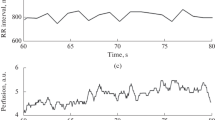Abstract
The technique of wavelet phase coherence analysis is introduced and used to explore relationships between oscillations on blood flow and temperature in the skin of 10 healthy subjects. Their skin temperature and blood flow were continuously recorded: under basal conditions for 30 min; during local cooling of the skin with an ice-pack for 20 min: and 30 min thereafter. The group mean basal skin temperature of 33.4°C was decreased to 29.2°C during the cooling period, and had recovered to 32.1°C by the end of the recording. The wavelet transform was used to obtain the time–frequency content of the two signals, and their coherence. It is shown that cooling increases coherence to a statistically significant extent in two frequency intervals, around 0.007 and 0.1 Hz, suggesting that these oscillatory components are involved in the regulation of skin temperature when cold is applied as a stress.
Similar content being viewed by others
References
Bračič M, and Stefanovska A. Wavelet based analysis of human blood flow dynamics. Bull Math Biol 60: 919-935, 1998.
Gustafsson H, Mulvany MJ, and Nilsson H. Rhythmic contraction of isolated small arteries from rat—Influence of the endothelium. Acta Physiol Scand 148(2): 153-163, 1993.
Johnson JM, Berngelmann GL, Hales JRS, Vanhoutte VPM, and Wenger CB. Regulation of the cutaneous circulation. Fed Proc 45: 2841-2850, 1986.
Kellogg DL, Zhao JL, Friel C, and Roman LJ. Nitric oxide concentration increases in the cutaneous interstitial space during heat stress in humans. J Appl Physiol 94(5): 1971-1977, 2003.
Kvandal P, and Stefanovska A, Veber M, Kvernmo HD, and Kirkebùen K-A. Regulation of human cutaneous circulation evaluatedd by laser Doppler flowmetry, iontophoresis, and spectral analysis: Importance of nitric oxide and prostaglandines. Microvasc Res 65: 160-171, 2003.
Nuzzaci G, Evangelisti A, Righi D, Giannico G, and Nuzzaci I. Is there any relationship between cold-induced vasodilataion and vasomotion? Microvasc Res 57: 1-7, 1999.
Paluš M, and Stefanovska A. Direction of coupling from phases of interacting oscillations: An information-theoretic approach. Phys Rev E 67: 055201(R), 2003.
Pikovsky A, Rosenblum M, and Kurths J. Synchronization—A Universal Concept in Nonlinear Sciences Cambridge, UK: Cambridge University Press, 2001.
Rosenblum MG, Cimponeriu L, Bezerianos A, Patzak A, and Mrowka R. Identification of coupling direction: Application to cardiorespiratory interaction. Phys Rev E 65: 041909, 2002.
Shusterman V, Anderson KP, and Barnea O. Spontaneous skin temperature oscillations in normal human subjects. Am J Physiol: Regulat Integr Comp Physiol 42: R1173-R1181, 1997.
Stefanovska A, Bračič M, Strle S, and Haken H. The cardiovascular system as coupled oscillators? Physiol Meas 22: 535-550, 2001.
Author information
Authors and Affiliations
Corresponding author
Rights and permissions
About this article
Cite this article
Bandrivskyy, A., Bernjak, A., McClintock, P. et al. Wavelet Phase Coherence Analysis: Application to Skin Temperature and Blood Flow. Cardiovascular Engineering 4, 89–93 (2004). https://doi.org/10.1023/B:CARE.0000025126.63253.43
Issue Date:
DOI: https://doi.org/10.1023/B:CARE.0000025126.63253.43




